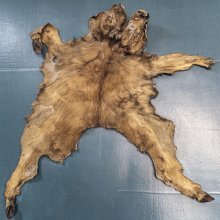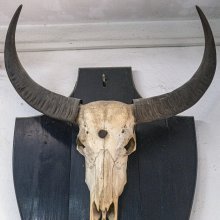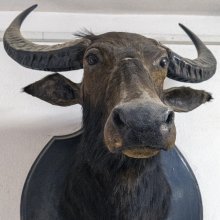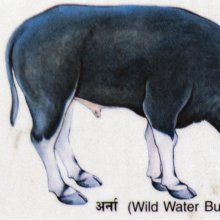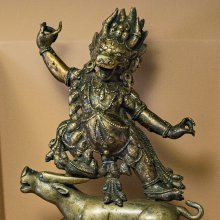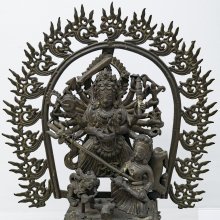Buffalo, Buffaloes: 4 definitions
Introduction:
Buffalo means something in Buddhism, Pali, Hinduism, Sanskrit, the history of ancient India. If you want to know the exact meaning, history, etymology or English translation of this term then check out the descriptions on this page. Add your comment or reference to a book if you want to contribute to this summary article.
Images (photo gallery)
(+9 more images available)
In Hinduism
Shilpashastra (iconography)
Source: Shodhganga: Elements of Art and Architecture in the Trtiyakhanda of the Visnudharmottarapurana (shilpa)The Buffalo in iconography is associated with Yama, according to the Viṣṇudharmottarapurāṇa, an ancient Sanskrit text which (being encyclopedic in nature) deals with a variety of cultural topics such as arts, architecture, music, grammar and astronomy.—In the context of having mahiṣa i.e., a buffalo as vāhana of Yama, the view points of the Viṣṇudharmottarapurāṇa , the Kāśyapaśilpa and the Śilparatna seem to be similar. Thus it is clear that the Viṣṇudharmottarapurāṇa offers a great field of knowledge regarding the nuances of Indian art of Image making [e.g., the buffalo] during 10th–11th century A.D.

Shilpashastra (शिल्पशास्त्र, śilpaśāstra) represents the ancient Indian science (shastra) of creative arts (shilpa) such as sculpture, iconography and painting. Closely related to Vastushastra (architecture), they often share the same literature.
Ayurveda (science of life)
Agriculture (Krishi) and Vrikshayurveda (study of Plant life)
Source: Shodhganga: Drumavichitrikarnam—Plant mutagenesis in ancient IndiaThe (Female) Buffalo is denoted by the Sanskrit term Mahiṣī, of which the urine and dung is used in certain bio-organical recipes for plant mutagenesis, according to the Vṛkṣāyurveda by Sūrapāla (1000 CE): an encyclopedic work dealing with the study of trees and the principles of ancient Indian agriculture.—Accordingly, “A seed of Nymphaea caerulea should be made moist with the mixture of urine and dried dung of a she-buffalo (mahiṣī) for seven days and after sowing it in rich soil should be nourished with coconut water (gale water?). It then grows into a Nerium indicum”.

Āyurveda (आयुर्वेद, ayurveda) is a branch of Indian science dealing with medicine, herbalism, taxology, anatomy, surgery, alchemy and related topics. Traditional practice of Āyurveda in ancient India dates back to at least the first millenium BC. Literature is commonly written in Sanskrit using various poetic metres.
In Buddhism
Tibetan Buddhism (Vajrayana or tantric Buddhism)
Source: academia.edu: The Structure and Meanings of the Heruka MaṇḍalaThe Buffalo is associated with the Yoginī (female deity) named Mahiṣī, being situated in the Medinīcakra, according to the 10th century Ḍākārṇava-tantra: one of the last Tibetan Tantric scriptures belonging to the Buddhist Saṃvara tradition consisting of 51 chapters.—Accordingly, the medinīcakra refers to one of the three divisions of the dharma-puṭa (‘dharma layer’), situated in the Herukamaṇḍala. The 36 pairs of Ḍākinīs [viz., Mahiṣī] and Vīras are yellow in color; the shapes of their faces are in accordance with their names [e.g., Buffalo]; they have four arms; they hold a skull bowl, a skull staff, a small drum, and a knife.

Tibetan Buddhism includes schools such as Nyingma, Kadampa, Kagyu and Gelug. Their primary canon of literature is divided in two broad categories: The Kangyur, which consists of Buddha’s words, and the Tengyur, which includes commentaries from various sources. Esotericism and tantra techniques (vajrayāna) are collected indepently.
India history and geography
Source: Singhi Jain Series: Ratnaprabha-suri’s Kuvalayamala-katha (history)Buffaloes were commonly traded with foreign merchants in ancient India, according to Uddyotanasūri in his 8th-century Kuvalayamālā (a Prakrit Campū, similar to Kāvya poetry).—The Kuvalayamala (779 A.D.) is full of cultural material which gains in value because of the firm date of its composition. [...] At Sūrpāraka there was a guild of local merchants. It was their custom to hold a reception in honour of merchants from outside and to learn from them the country of their origin, the destination, field of trade, the nature, value and volume of commodity in which he is interested and all such matters relating to his business. [...] One said: “I went to China (Indo-China) and Mahācīna (great Chinese mainland) taking buffaloes and the naval dear and brought from there two kinds of fabrics named gaṅgāpaṭṭa and netrapaṭṭa” [...]

The history of India traces the identification of countries, villages, towns and other regions of India, as well as mythology, zoology, royal dynasties, rulers, tribes, local festivities and traditions and regional languages. Ancient India enjoyed religious freedom and encourages the path of Dharma, a concept common to Buddhism, Hinduism, and Jainism.
See also (Relevant definitions)
Starts with: Buffalo bellow plant, Buffalo berry, Buffalo clover, Buffalo couch, Buffalo couch grass, Buffalo currant, Buffalo grass, Buffalo milk, Buffalo nut, Buffalo plum, Buffalo quick grass, Buffalo reed, Buffalo thorn, Buffalo-sacrifice, Buffalo-tongue berkheya, Buffalo-weed, Buffalograss.
Ends with: Curly buffalo.
Full-text (+879): Mahisha, Mahishi, Sairibha, Krishnashringa, Mahishika, Kasara, Heramba, Gavala, Aushtra, Rajasvala, Ashvamahishika, Ushtra, Japharabadi, Lulaya, Kapadanem, Tonaga, Lulapa, Vishatvara, Raktaksha, Anupa.
Relevant text
Search found 195 books and stories containing Buffalo, Buffaloes; (plurals include: Buffalos, Buffaloeses). You can also click to the full overview containing English textual excerpts. Below are direct links for the most relevant articles:
Folklore of the Santal Parganas
Chapter 6 - The Wild Buffaloes < [Appendix]
Chapter LXII - Spanling and His Uncles < [Part I]
Chapter LXXI - Lakhan and the Wild Buffaloes < [Part I]
The Jataka tales [English], Volume 1-6 (by Robert Chalmers)
Jataka 278: Mahisa-jātaka < [Book III - Tika-Nipāta]
Jataka 322: Daddabha-jātaka < [Volume 3]
Jataka 143: Virocana-jātaka < [Book I - Ekanipāta]
Animal Kingdom (Tiryak) in Epics (by Saranya P.S)
Chapter 4.5 - The Buffalo (Mahisha) in the Epics
Chapter 2.5 - The origin of the flora and fauna in the Puranas
The Myths Of The North American Indians (by Lewis Spence)
Chapter VI - Myths and Legends of the Pawnees
Chapter III - Algonquian Myths and Legends
Manusmriti with the Commentary of Medhatithi (by Ganganatha Jha)
Verse 3.166 < [Section VIII - Śrāddhas]
Verse 5.8 < [Section II - Objectionable Food]
Verse 8.241 < [Section XXXIX - Disputes between Owner and Keeper]
Trishashti Shalaka Purusha Caritra (by Helen M. Johnson)
Part 3: Former births of the cocks < [Chapter IV - Tenth incarnation as Megharatha]
Part 7: Birth as Dhūsarī, wife of Dhanya < [Chapter III - Vasudeva’s Marriage with Kanakavatī and her Former Incarnations]
Part 4: Cure of Lakṣmaṇa < [Chapter VII - The killing of Rāvaṇa]
Related products
